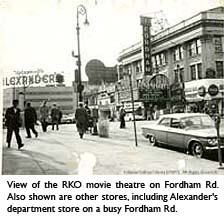Fordham

Fordham ("village by the ford") refers to a settlement near a shallow crossing of the Harlem River, until 1693 the only entry to Manhattan from the north. The large manor which took the name originally stretched from the Harlem to the Bronx River, and south from what is today Kingsbridge Road to Highbridge. Divided into farms after the failure of the original sixteenth-century grantholder, John Archer, Fordham's rural anonymity went undisturbed until the New York and Harlem Railroad, pushing north, opened a station at what is now Fordham Road and Webster Avenue in 1841. Two responses to this new accessibility are recalled by sites in the neighborhood. In 1845 Edgar Allan Poe brought his ailing wife from Manhattan to rural Fordham. On Grand Concourse, across the street from its original location, stands the cottage where the Poes lived, and where he wrote "Annabell Lee" and "The Bells". Even closer to the railroad line is the campus of Fordham University, which was opened by Bishop John Hughes as St. John's College in 1841. Like most of the northern Bronx, the Fordham area remained dormant until cheap public transportation supplemented the rail line. In rapid succession, the Third Avenue El (1903), the Jerome Avenue IRT (1914), and the IND under Grand Concourse (1933) opened the neighborhood to emigrees from Manhattan and the lower Bronx. By the 'thirties Fordham Road, the main east-west thoroughfare, had replaced 149th Street as the borough's major shopping and entertainment center.
[Back to Index]